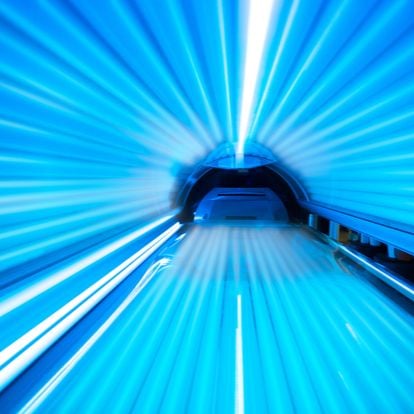 OVERVIEW
OVERVIEW
Many people use tanning beds as a way to achieve a year-round tan. People erroneously believe that tanning beds are safer than sun tanning; that tanning beds can help build a base tan to ward off sunburns; and that the tanning beds can treat low vitamin D levels. The truth about tanning beds is anything but. Tanning beds pose significant health risks and aren’t safe to use.
UV Radiation and Tanning:
To understand the dangers of tanning bed use, it is helpful to review the basics regarding sun exposure, UV radiation, and tanning.
The sun emits UV radiation in the form of UVA, UVB, and UVC. UVA rays, which are the longest, penetrate the deepest in the skin and are responsible for tanning and premature aging. UVB rays are shorter and responsible for vitamin D production in the skin. UVB rays are also the cause of sunburning. UVC rays, which are the shortest, are absorbed by the ozone layer and do not reach the surface of the earth.
Similar to the sun, tanning beds also emit UV radiation. Tanning beds emit mostly UVA, but also smaller doses of UVB. The UVA radiation in tanning beds can be much more intense than that of natural sunlight.
It is important to understand that tanning of the skin occurs as a result of damage to your skin. There is nothing “healthy” about a tan - whether it is achieved through natural sun exposure or artificial tanning beds. In fact, the bronzing of the skin signifies that damage has already occurred to your skin cells. As UV radiation reaches your skin, it causes damage to your skin cells. This damage to your skin cells is ultimately responsible for the generation of precancers and skin cancers. As a response to the injury, your body produces more pigment in the skin (called melanin) in an attempt to protect the cells from further UV radiation.
What are the Dangers of Tanning Beds?
- Cancer Risks
The International Agency for Research on Cancer (part of the World Health Organization) has labeled tanning beds as the highest cancer risk category: "carcinogenic to humans". In other words, the use of tanning beds is linked to the development of skin cancer.
In 2002, a National Cancer Institute study found that tanning bed use was associated with a 50% increase in the risk of developing a basal cell carcinoma and more than 100% increase in the risk of developing a squamous cell carcinoma. Studies have also concluded that people who start tanning before the age of 35 are at a 75% greater risk of developing melanoma, a deadly form of skin cancer. There has even been an association between use of tanning beds and cancer of the eye (ocular melanoma). Even a single trip to the tanning salon can significantly increase your risk for developing melanoma, a deadly skin cancer. - Premature Aging of the Skin
Tanning also leads to premature aging of the skin. Affected skin can appear wrinkled and leathery. Too much UV exposure can also lead to the development of brown spots (age spots, freckles) and more prominent blood vessels (telangiectasias). The skin loses its elasticity and begins to sag. - Eye Damage
Exposing your eyes to UV radiation can also cause irreversible damage to your eyes, often with long-term consequences for your vision. - Immune Suppression
UV rays have been shown to suppress our immune system responses, leaving us more susceptible to infectious and skin cancers.
What about Vitamin D?
Vitamin D is essential for bone health and has been linked to a reduced risk for several cancers. UVB exposure stimulates the skin’s production of vitamin D.
Most people can get enough vitamin D just from incidental sun exposure on the face and hands in a few minutes of the day. The American Academy of Dermatology recommends getting vitamin D from a healthy diet that includes foods naturally rich in vitamin D; foods or beverages fortified with vitamin D; and/or the use of vitamin D supplements.
When to See a Dermatologist
Dermatologists recommend routinely checking your skin and scheduling an appointment to evaluate any new, unusual, changing, or symptomatic growths.

 OVERVIEW
OVERVIEW
